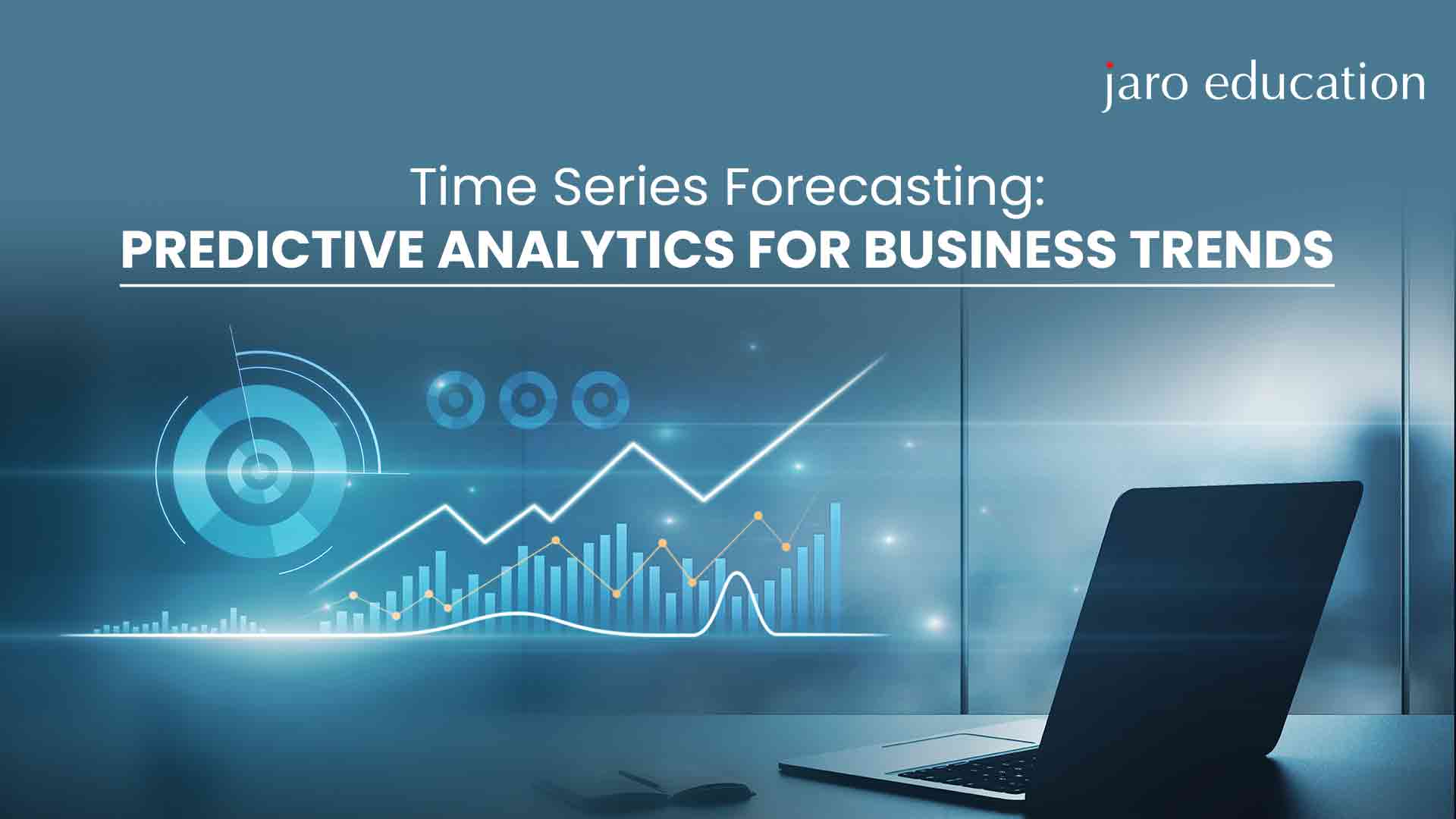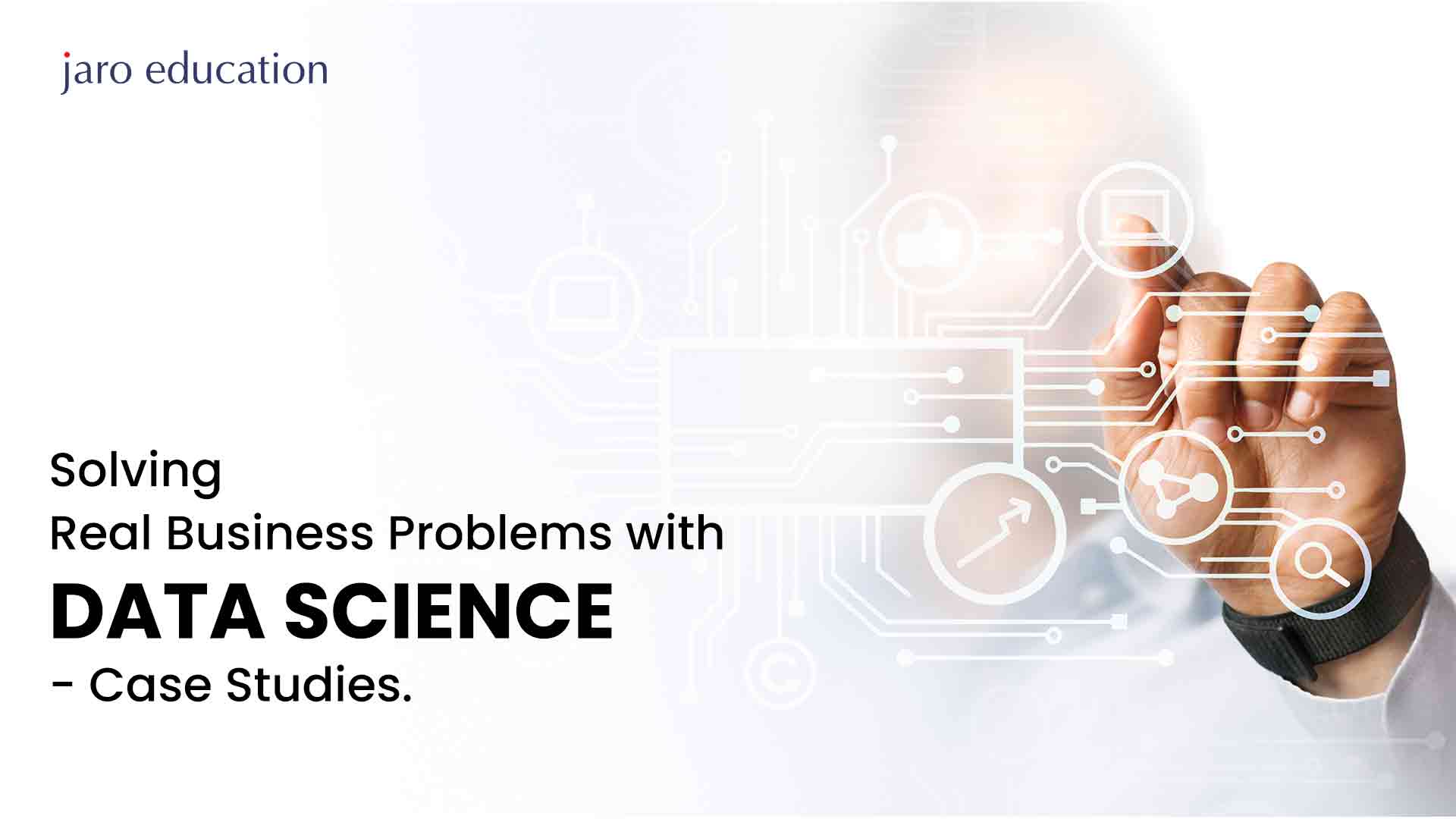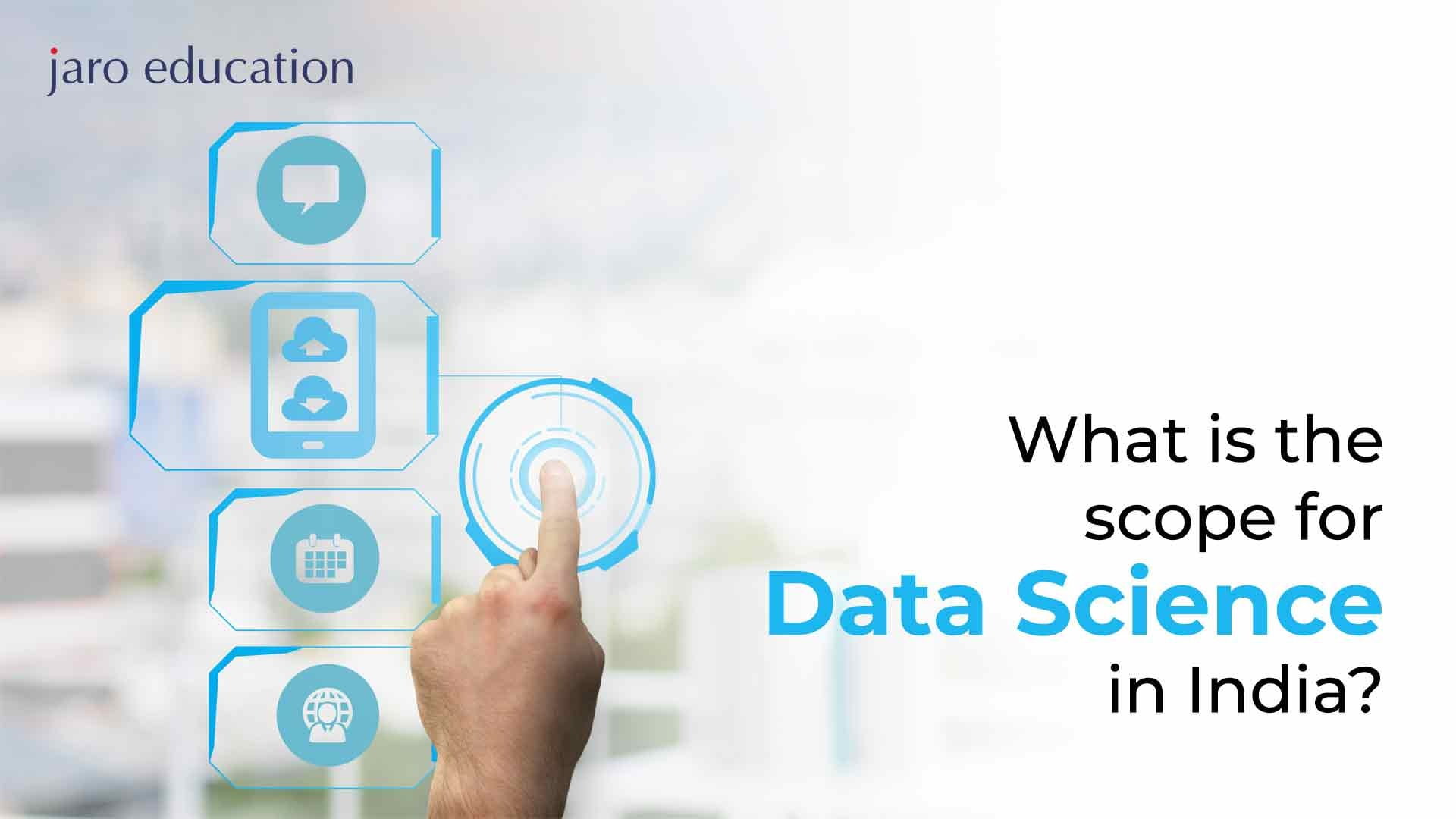
- jaro education
- 15, March 2024
- 2:00 pm
Leveraging the power of time series forecasting is like finding a treasure chest for your business. This technique helps you predict future trends in key areas such as revenue, expenses, and profitability by using your past data. Whether you’re just starting out in business or have been at it for a while, using time series forecasting can greatly improve your planning.
By looking closely at past data, time series forecasting helps you to figure out what might happen in the future and plan ahead in a smart way. It’s worth noting that when you do forecasting, you don’t know for sure what’s going to happen later on, so you have to use information you already have and analyze it carefully. Through this blog, you’ll learn more about time series forecasting, the different ways it’s done, and why it’s so important for making smart decisions.
This article explains why time series forecasting is important. We’ll talk about different forecasting methods, from basic ones like ARIMA to more advanced techniques like neural networks, and how they can help you make better decisions using data. By the end, you’ll understand how these forecasting models work and how they can help entrepreneurs make smarter decisions for their businesses.
Understanding Time Series Forecasting
Table of Contents
Time series forecasting is a crucial aspect of predictive analytics which involves the examination of time series data through statistical analysis and modeling to make predictions, influencing strategic decision-making. Predictions are not always precise, and the probability of forecasts can vary, particularly when dealing with fluctuating variables inherent in time series data and external factors beyond our control.
Nonetheless, forecasting provides insights into the likelihood of certain outcomes compared to others. The accuracy of forecasts tends to improve with more comprehensive data.
While the terms “forecasting” and “prediction” are often used interchangeably, there is a distinct difference. In some industries, forecasting may pertain to specific data at a future point in time, while prediction encompasses future data more broadly. Time series forecasting is usually employed in tandem with time series analysis.
Besides that, Time series analysis involves constructing models to comprehend the data and identify underlying causes, offering insights into the “why” behind observed outcomes. Forecasting then takes the subsequent step of determining how to apply that knowledge and making foreseeable extrapolations about future occurrences.
Various industries and scientific domains find practical applications in time-series forecasting. Noteworthy fields leveraging this methodology include:
- Business planning
- Control engineering
- Cryptocurrency trends
- Financial markets
- Modeling disease spreading
- Pattern recognition
- Resources allocation
- Signal processing
- Sports analytics
- Statistics
- Weather forecasting
The scope of applications extends beyond this list. Essentially, anyone with access to precise historical data can employ time-series analysis techniques to predict future developments and trends.
You can learn all forecasting methods with the Professional Certificate Program in Data Science for Business Decisions from IIM Kozhikode. Designed for tech professionals, mid-level managers, early managers/team leads, senior executives, and others, this course provides a thorough curriculum and an interactive learning method. Participants will gain an in-depth understanding and crucial skills in supervised and unsupervised learning, social media analytics, big data technologies, and related areas.

*mlpills.dev
Factors to Consider in Time-Series Forecasting
Time-series forecasting involves various considerations that significantly impact the accuracy and reliability of predictions. Among these factors, the following are crucial:
Amount of Data
The quantity of data is paramount, assuming its accuracy. A general guideline is that a larger dataset improves the model’s forecasting capabilities, aiding in distinguishing trends from noise.
Data Quality
Basic requirements for data quality include the absence of duplicates, a standardized data format, and consistent or regular data collection intervals.
Seasonality
Seasonality refers to distinct periods when data exhibits consistent irregularities. For instance, analyzing the sales history of an online store may reveal increased sales during the holiday season. Time-series forecasting becomes invaluable in detecting such consumer behavior beyond intuitive correlations.
Trends
Identifying trends is crucial, indicating whether a variable in the time series is likely to increase or decrease over a specific period. Calculating the probability of a trend enhances decision-making based on the data.
Unexpected Events
Also known as noise or irregularities, unexpected events can disrupt historical data and are unpredictable. Accounting for these events is essential when constructing a prediction model.
Utilizing Predictive Analytics for Time Series Forecasting
Predictive analytics is crucial within the field of data science, allowing us to derive valuable insights from past data in order to make reliable predictions about what may happen in the future. In particular, when it comes to forecasting trends over time, predictive analytics is highly beneficial for businesses operating in a variety of sectors.
By analyzing and understanding patterns, predictive analytics helps organizations uncover hidden trends and identify areas for improvement. This empowers decision-makers to base their choices on data, optimize their processes, and gain a competitive edge in their respective markets.
Time series forecasting is a specialized method of predictive analytics focused on analyzing and predicting data points collected over time. Its applications are diverse, ranging from predicting sales figures to analyzing stock market trends, forecasting demand, predicting weather patterns, and more.
Time-Series Forecasting Methods to Analyze Business Trends
Naive and Seasonal Naive Approaches
The Naive and Seasonal Naive approaches are straightforward methods for time series forecasting. The Naive method assumes that the most recent observation is the best predictor for the future, simply projecting it forward. This method is particularly useful for stable series without clear trends or seasonal patterns. On the other hand, the Seasonal Naive approach accounts for seasonality by assuming that the observation from the last season will repeat itself in the current season. It’s effective for series with strong, consistent seasonal patterns, using past season data as the forecast for the same season in the future.
Moving Averages and Exponential Smoothing
Moving Averages and Exponential Smoothing methods smooth out time series data to identify trends and patterns. Moving Averages use past data points to produce a series of averages, helping to smooth out short-term fluctuations and highlight longer-term trends or cycles. Exponential Smoothing assigns exponentially decreasing weights to older observations, with Simple Exponential Smoothing (SES) focusing on level, Double Exponential Smoothing (DES) on level and trend, and Triple Exponential Smoothing (TES) on level, trend, and seasonality. These methods are foundational in time series forecasting for their simplicity and effectiveness in dealing with different data patterns.
Decomposition Methods
Decomposition methods break down a time series into trend, seasonal, and residual components. This approach can use techniques like Seasonal and Trend decomposition using LOESS (STL), distinguishing between additive and multiplicative models. Additive models are used when seasonal variations are roughly constant through the series, while multiplicative models are better when seasonal variations change proportionally to the level of the series. Decomposition allows for more accurate forecasting by analyzing and modeling these components separately.
ARIMA Method
The Autoregressive Integrated Moving Average (ARIMA) method combines autoregressive and moving average components with differencing to stabilize the series. It’s effective for analyzing univariate time series data that show patterns or trends but may not exhibit seasonality. ARIMA models are defined by three parameters:
- p for the number of lag observations (autoregressive part),
- d for the degree of differencing needed for stationarity, and
- q for the size of the moving average window.
Seasonal ARIMA (SARIMA) extends ARIMA to handle seasonal effects by adding seasonal terms.
State Space Models and Kalman Filtering
State Space Models and Kalman Filtering are advanced methods used in time series forecasting to model and predict linear dynamic systems. State Space Models represent the time series data in terms of a system of equations that capture the relationships between the observations and their underlying state. Kalman Filtering, a recursive algorithm within this framework, estimates the states of a linear dynamic system from a series of noisy measurements. It’s particularly useful for situations where the data is observed over time with inaccuracies or noise, allowing for real-time updates to forecasts as new data becomes available.
Machine Learning Approaches
Machine Learning Approaches in time series forecasting use algorithms such as Random Forest, Gradient Boosting, and Neural Networks to model complex patterns in data. These methods can capture nonlinear relationships and interactions between variables without requiring explicit model specification, offering advantages in handling large datasets with multiple input features. Machine learning models are flexible and can improve forecast accuracy, especially in situations where traditional statistical models might fall short due to the complexity of the underlying data structure.
Deep Learning for Time Series Forecasting
Deep Learning for Time Series Forecasting primarily utilizes Long Short-Term Memory (LSTM) networks, a type of recurrent neural network (RNN) designed to learn order dependence in sequence prediction problems. LSTMs are particularly well-suited for forecasting time series data due to their ability to capture long-term dependencies and patterns in time series, overcoming the limitations of traditional models in handling sequences with various lengths and complexities. They are used for complex forecasting tasks that involve large datasets with intricate temporal behaviors.
TBATS method
TBATS is an acronym representing a powerful model designed to address the complexities found in many time series datasets, which often exhibit intricate and multiple seasonal patterns. Traditional models like ARIMA and exponential smoothing are limited to accommodating only one seasonality factor.
The distinctive strength of TBATS lies in its ability to handle intricate seasonal patterns, including non-integer, non-nested, and large-period seasonality, without imposing constraints. This flexibility allows for the creation of detailed and accurate long-term forecasts. However, it’s important to note that the use of TBATS models comes with a trade-off. They can be computationally slow, particularly when predicting outcomes for extensive time series datasets.
Breaking down the acronym, TBATS encompasses essential features of the model:
- T: Trigonometric seasonality
- B: Box-Cox transformation
- A: ARIMA errors
- T: Trend
- S: Seasonal components
Collectively, these components contribute to TBATS’ effectiveness in capturing and forecasting the intricate patterns present in diverse time series data, offering a valuable tool for businesses seeking detailed and robust predictive analytics solutions.
Application of Time Series Forecasting and Predictive Analytics
Predictive analytics and time series forecasting are widely utilized across various industries due to their versatile applications. Let’s explore several key areas where these methodologies are enhancing trend analysis:
Demand Forecasting in Business:
- Retail: Accurate demand forecasting helps retailers optimize inventory levels, manage supply chains efficiently, and plan promotions effectively.
- Procurement: Predicting demand for raw materials or components ensures timely procurement and cost-effective inventory management.
- Dynamic Pricing: By analyzing historical sales data, businesses can adjust prices dynamically based on demand fluctuations.
Sales Prediction:
- Predictive models analyze historical sales patterns to forecast future sales. This information aids sales teams in setting targets, allocating resources, and planning marketing campaigns.
Financial Domain:
- Stock Market Trends: Time series analysis helps investors and traders predict stock price movements by analyzing historical stock data.
- Economic Indicators: Predictive analytics can forecast economic indicators like GDP growth, inflation rates, and interest rates, aiding financial decision-making.
Marketing and Customer Behavior:
- Customer Segmentation: Predictive models segment customers based on behavior, preferences, and purchase history. This informs targeted marketing strategies.
- Churn Prediction: By analyzing customer churn patterns, businesses can take preventive measures to retain valuable customers.
Supply Chain Optimization:
- Inventory Management: Accurate demand forecasting minimizes excess inventory and stockouts, improving supply chain efficiency.
- Production Planning: Predictive analytics helps optimize production schedules, resource allocation, and capacity planning.
Energy and Utilities:
- Load Forecasting: Utilities use time series models to predict electricity demand, ensuring efficient power generation and distribution.
- Equipment Maintenance: Predictive maintenance based on historical data prevents equipment failures and reduces downtime.
Conclusion
Time-series forecasting is a valuable tool for businesses to predict future trends and values in their data. It can greatly aid in business development, especially if historical data with a time component is available. While there are many forecasting methods to choose from, they are often tailored to specific situations and types of data, simplifying the selection process for businesses. By harnessing the power of time-series forecasting, businesses can make informed decisions and stay ahead in their respective markets.









